Ticks on Dogs -The Complete Guide
Get to know the ticking time bomb in the backyard. Get rid of those tenacious ticks before they latch onto your dog. Learn what to do when your dog gets bitten and how to prevent any further infection with our complete guide on dog ticks.
TICKS ON DOGS
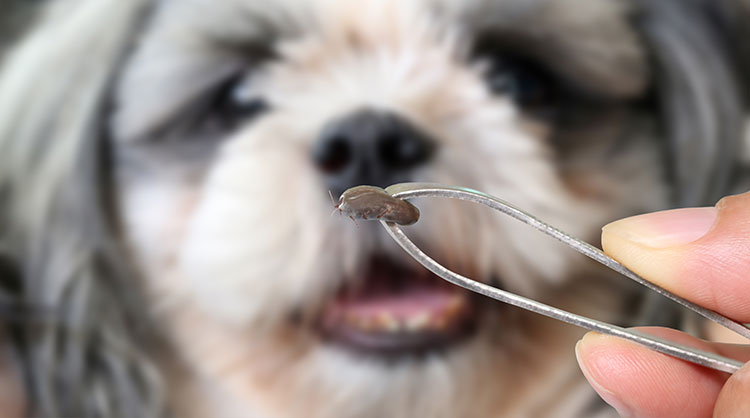
Posted by bravectosouthafrica – 26 September 2019
Guide to Ticks on Dogs in South Africa
- What causes ticks on dogs?
- Where do ticks come from?
- Different types of ticks on dogs in South Africa
- Symptoms of tick bite in dogs
- How to prevent ticks on dogs
- How to find ticks on dogs
- How to remove a tick from a dog
- How to kill ticks on dogs
- Prepare for tick season
- How does Bravecto® tick control work?
What Causes Ticks on Dogs?
South Africa’s long grass, rural plots and rodents help ticks thrive. They prefer a humid and moisture-rich environment, but some species have adapted to different settings. Ticks are part of the arachnid family, making the spider a distant cousin. To avoid an encounter in your home, keep lawns mowed, houses vacuumed and check for any signs of ticks on dogs.
Where Do Ticks Come From?
Pinpointing different species to specific regions is tricky, as most of the country’s ticks can live in various environments. But, as mentioned before, these critters have a preference. Ticks prosper in the rainy season and you may notice a steep increase in your region’s tick population overnight.
Ticks generally live outdoors in grassy and woody areas, but some species have adjusted to cool climates. These ticks can survive in your home, which is, frankly, too close for comfort. To climb onto a host, ticks will sit on the tips of grass blades or bushes and patiently wait to hitch a ride on a foot or paw.
Luckily, these blood-sucking bugs can’t fly or jump and are easily thwarted. If you have the right preventive measures in place, your whole household will be safe from ticks.
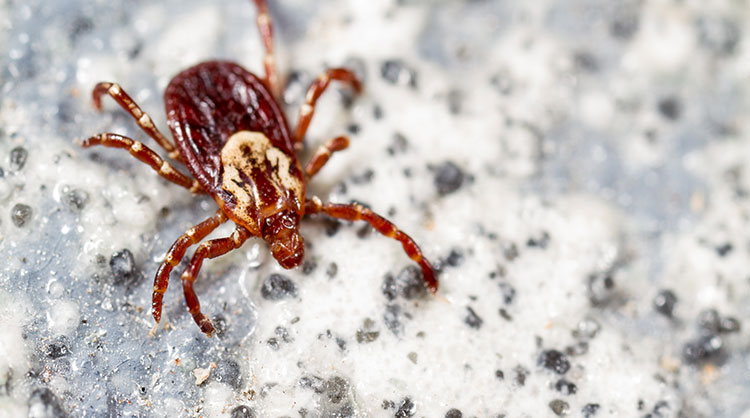
Different Types of Ticks on Dogs in South Africa
More than 800 tick species make up the tick family. Keep the tick that stuck to your dog in a jar for the vet to take a look at, should your pup become sick. Your veterinarian can inspect the specimen in your jar and determine whether it was a carrier of a disease.
The many tick species in the world can be divided into two groups, namely hard ticks and soft ticks. Soft ticks have a raisin-like body and favour poultry and bats above larger mammals. Hard ticks have a shield-like cover over their bodies, and unfed, they can look like a flat seed.
South Africa has many types of ticks, but when it comes to identifying dog ticks, the chances are that you have encountered the yellow or brown variety.

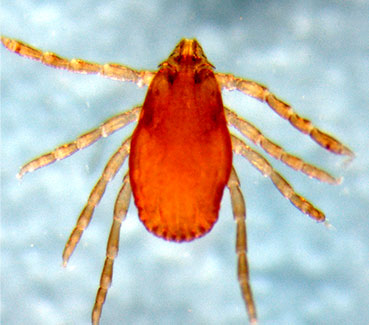
| Types of Ticks on Dogs | |
|---|---|
| South African Yellow Dog TickHaemaphysalis ellipticaSouth African yellow dog ticks are eyeless and have an orange or yellow body. The edge of the tick’s body has small but prominent indents. Their mouthparts are short and triangular. These ticks prefer to attach to the upper part of an animal, the head, shoulders and neck in particular. Dogs in the eastern part of South Africa are more at risk, especially in regions with heavy rainfall.South African Yellow Dog Tick Quick FactsThree-host tickYellow or orangeEyelessCan lay 5000 eggs within two weeksPresent from winter to springCauses Babesiosis (Biliary) | Kennel Tick AKA Brown Dog TickRhipicephalus sanguineusThe kennel tick is seed-shaped with a smooth, yet indented, reddish-brown body. When the tick has fed, its body will become salmon pink. This pest has clear eyes and slightly rounded mouthparts that make engorging possible anywhere on the animal’s body. These ticks prefer canine hosts. Pups throughout the country are at risk as the kennel tick flourishes in kennels and home environments.Brown Dog Tick Quick FactsThree-host tick with a preference for dogsYellowish or reddish-brownDistinct, convex eyesCan lay 5000 eggs within two monthsAdapts well to most, except desert-like, conditionsCauses canine ehrlichiosis |

Spot the Signs of a Tick Bite on Your Dog: Symptoms of Biliary (Tick Bite Fever) in Dogs
Whether the tick is on your dog or it’s fallen off, there are symptoms of tick fever you can look out for in case of an emergency. If you have an idea of the signs, you can avoid a potentially disastrous situation. Know that the symptoms listed below don’t constitute a diagnosis. If you suspect your pet is ill, take them to your vet
- Fever
- Jaundice (yellowish tongue, gums or eyes)
- Lacking energy
- Loss of appetite
- Dark-coloured urine
- Weight loss
- Swollen lymph nodes
- Anaemia (white or pale gums)
- Abnormal eating behaviour (eating dirt or concrete)
- Vomiting or regurgitation
- Unsteadiness
- High blood pressure
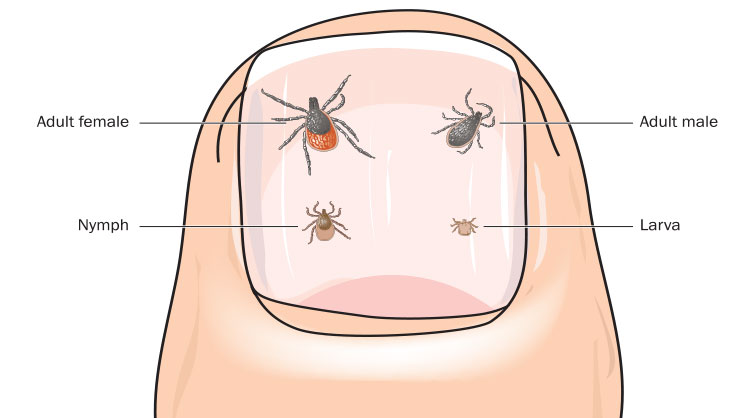
Top Tick Threat for youd dog in SA
Yellow and brown dog ticks are the most common pests that can transfer life-threatening diseases to their canine hosts. Babesiosis and canine ehrlichiosis are the top infections to look out for.
Babesiosis, (also known as tick fever or biliary fever), causes haemolytic anaemia as babesia parasites break down red blood cells. Diagnosis may be tricky as some pets may not have any symptoms. If left untreated, a dog may need a blood transfusion and hospitalisation
Canine ehrlichiosis (also known as tropical canine pancytopenia, typhus, canine haemorrhagic fever, tracker dog disease and canine rickettsiosis), can also affect humans and occurs in three stages: acute (lasting a few weeks), subclinical (can last a lifetime), and chronic (possibly fatal).
The chronic, and most severe, stage of canine typhus suppresses bone marrow and can lead to kidney disease, neurological and eye disorders, lameness, bleeding and pancytopenia.
Prevention is the best option. If you find a tick on yourself, take care to remove the whole tick slowly with a pair of tweezers.
Did you know that Bravecto® gets rid of ticks on dogs, and also keeps your pup safe from pests like ticks for up to 4 months? Protection with Bravecto® Chews lasts for 12 weeks and Bravecto® Spot-On lasts 4 months. Have a look at the video below to learn more about effective tick control.

3 Step Guide on How to Prevent Ticks on Dogs
Tick prevention for dogs is vital to control infestation and trips to the vet. If you take preventive measures, you can go on an adventure with your pup and know he’ll be safe from ticks during and after your trip. Go on the offence, and fight ticks on their ground before they breach your home.
Tick-proof Your Property
Start with the perimeter of your property. Scatter or spray preventative tick spray around your home and areas that previously housed ticks. Ticks prefer to find another safe zone, away from your property, when they detect pesticide
It’s important to maintain and mow the lawn and frequently vacuum your home to dissuade ticks from making your home theirs. Make sure you have a neat and tidy yard.
Check Your Pup Daily
Run your hands through your dog’s fur daily, and pay particular attention to the tick hotspots. Check your dog’s face, neck, ears, toes (in between), groin and tail area, and under their front legs. Ticks crawling amongst a dog’s fur can be brushed off and be disposed of by smothering them in alcohol.
Tick Protection Medications and Treatments
There is a variety of tick treatments available for dogs. Discuss your options with your vet, especially if your pet has allergies or skin conditions. Tick prevention that lasts for months as opposed to a week or two is ideal as extended protection is the best way to decrease the risk of your dog getting a tick-borne disease.
Popular tick treatment for dogs include:
- Oral medication like Bravecto® Chews
- Spot-On Treatment (Bravecto® Spot-On lasts for 4 months)
- Anti-tick shampoo
- Tick dips
- Powders
- Tick sprays
- Tick collar

Where to Find Ticks on Dogs
Usually, ticks can be found enjoying humid places. They’re most prevalent in a dog’s nooks and not out in the open. Incorporate a tick search into your dog’s daily grooming and petting sessions.
Small ticks can be removed by brushing your dog with a dense bristle brush twice daily. As for large ticks, run your hands through your dog’s fur to find them. Part the dog’s hair at prime tick spots, like the paws and behind ears.
Double-check a tick’s top feeding areas. Here are the tick bite hot spots on a dog:
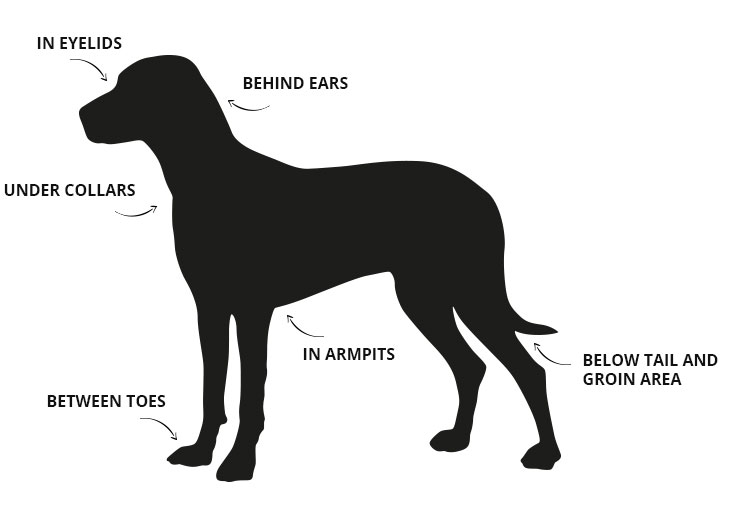

Tick on dog tweezer removal method
If you face an infestation, you might want to try to remove a tick from your dog with Vaseline – don’t. Vaseline and other home remedies are no-good because they can cause a tick to dig deeper into the skin.
Removing dog ticks require a pair of tweezers or a special tick-removal tool, and gloves. Follow these steps to banish them from your dog and home::
- Wear disposable gloves to shield your hands from bacteria. Alternatively, protect your hands with tissue paper. Pets can carry harmful agents that they’re immune to, but that can lead to human diseases.
- Grab a fine-tipped pair of tweezers or a special tick removal tool.
- Use the tweezers to pinch the tick on a dog as close to the skin as possible to avoid leaving the tick head stuck on the dog.
- If you’re using tweezers, pull the tick out slowly and steadily . With continual pressure, the tick will release eventually, but the process may take a few minutes. A pair of tick twisters and a tick key are special tools that make tick removal easy. However, you must remain cautious and careful not to twist or jerk a tick violently as this can dislodge its mouthparts and lead to infection.
- Disinfect the bite area and your hands.
- Put the tick in a jar with alcohol to preserve it for identification if your dog exhibits signs of vector-disease. Add a note or sticker with the date and details of the incident to help your vet or physician if the need arises.
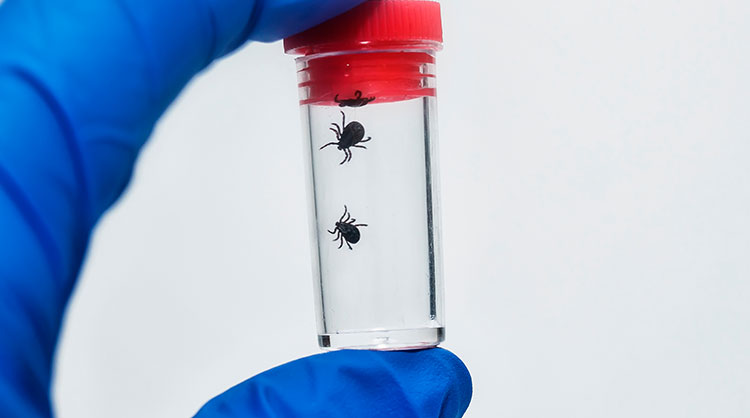
How to Kill Ticks on Dogs
Now that the ticks are removed from your dog you can move on to disposing of them for good. Tick protection will kill ticks, but to make sure that they are dead, you can smother the culprit in alcohol or place it in an airtight container.
Ticks are killed most effectively using alcohol.

Be Prepared for Tick Season
Ticks can be prevalent throughout the year, but when temperatures heat up, they thrive. Although tick season extends from spring to autumn, you should protect your dog from infestation year-round.
Some tick species have acclimatised to cooler climates, which make them tricky to avoid. As no one can predict when a tick will latch onto a host, it’s best to incorporate preventative measures into your routine.
How Does Bravecto® Tick Control Work?
Bravecto® has two potent products that kill and remove ticks. These treatments last three times longer than other tick control and provide long-lasting protection for your dog (and cat). Protect your pup with these easy-to-administer treatments:
Bravecto® Chews
Let your dog lap up one dose of Bravecto® Chew by adding it to your dog’s food or feed it to him as you would a treat. The tick-killing product enters an animal’s bloodstream and effectively kills ticks on dogs within 12 hours. This killing effect will last for 12 weeks, which means pet owners only have to treat 4 times a year and have peace of mind for longer.
Bravecto® Spot-On
Bravecto® Spot-On treatment is administered on the skin between a pet’s shoulders. One dose can eliminate ticks (for 4 months) and fleas (for 6 months). Within 12 hours, Bravecto® Spot-On kills 100% of ticks on dogs.
Learn more about Bravecto® products or find a stockist near you and protect your pets today!
Subscribe to our Newsletter
Get to know your furry friend better! Sign up for all things dog- or cat-related.
The Hairy Facts about the dreaded hairball
12 April 2021
Help! My dog’s barking mad! Volume 2
12 April 2021
Your Itchy, Scratchy Cat – All About Cat Skin Problems
12 April 2021
The Dog’s Diet: A Bone of contention?
01 April 2021
Mango Fly Worms: How to Spot and Eliminate them
Posted on November 28,2019
Managing Mange And Mites In Your Dog
Posted on June 11,2018
Why Do Cats Purr and How? Learn What Your Cat Is Saying
Posted on October 14,2020
How to Get Rid of Ear Mites in Dogs
Posted on November 06,2019









